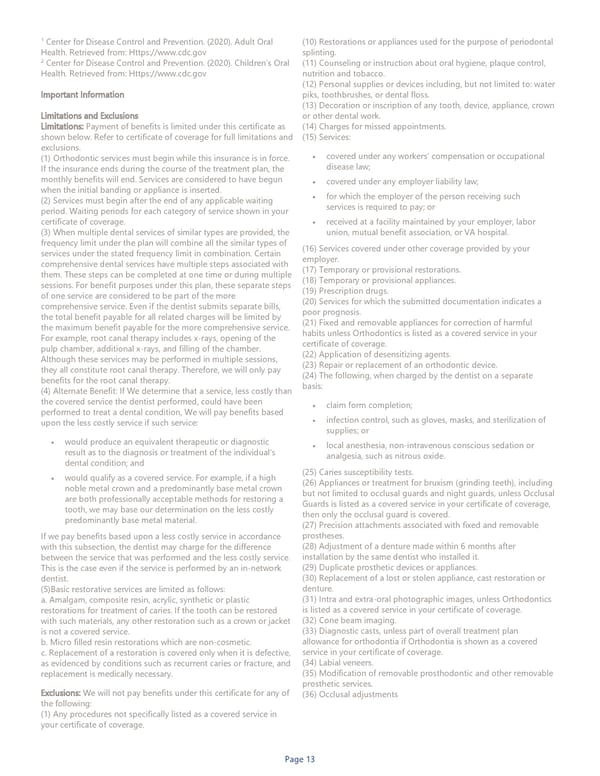Page 13 Center for Disease Control and Prevention. (2020). Adult Oral 1 Health. Retrieved from: Https://www.cdc.gov Center for Disease Control and Prevention. (2020). Children’s Oral 2 Health. Retrieved from: Https://www.cdc.gov Important Information Limitations and Exclusions Payment of benefits is limited under this certificate as Limitations: shown below. Refer to certificate of coverage for full limitations and exclusions. Orthodontic services must begin while this insurance is in force. (1) If the insurance ends during the course of the treatment plan, the monthly benefits will end. Services are considered to have begun when the initial banding or appliance is inserted. Services must begin after the end of any applicable waiting (2) period. Waiting periods for each category of service shown in your certificate of coverage. When multiple dental services of similar types are provided, the (3) frequency limit under the plan will combine all the similar types of services under the stated frequency limit in combination. Certain comprehensive dental services have multiple steps associated with them. These steps can be completed at one time or during multiple sessions. For benefit purposes under this plan, these separate steps of one service are considered to be part of the more comprehensive service. Even if the dentist submits separate bills, the total benefit payable for all related charges will be limited by the maximum benefit payable for the more comprehensive service. For example, root canal therapy includes x-rays, opening of the pulp chamber, additional x-rays, and filling of the chamber. Although these services may be performed in multiple sessions, they all constitute root canal therapy. Therefore, we will only pay benefits for the root canal therapy. Alternate Benefit: If We determine that a service, less costly than (4) the covered service the dentist performed, could have been performed to treat a dental condition, We will pay benefits based upon the less costly service if such service: • would produce an equivalent therapeutic or diagnostic result as to the diagnosis or treatment of the individual’s dental condition; and • would qualify as a covered service. For example, if a high noble metal crown and a predominantly base metal crown are both professionally acceptable methods for restoring a tooth, we may base our determination on the less costly predominantly base metal material. If we pay benefits based upon a less costly service in accordance with this subsection, the dentist may charge for the difference between the service that was performed and the less costly service. This is the case even if the service is performed by an in-network dentist. Basic restorative services are limited as follows: (5) a. Amalgam, composite resin, acrylic, synthetic or plastic restorations for treatment of caries. If the tooth can be restored with such materials, any other restoration such as a crown or jacket is not a covered service. b. Micro filled resin restorations which are non-cosmetic. c. Replacement of a restoration is covered only when it is defective, as evidenced by conditions such as recurrent caries or fracture, and replacement is medically necessary. We will not pay benefits under this certificate for any of Exclusions: the following: Any procedures not specifically listed as a covered service in (1) your certificate of coverage. Services which are not deemed to be necessary care or (2) Restorations or appliances used for the purpose of periodontal (10) splinting. Counseling or instruction about oral hygiene, plaque control, (11) nutrition and tobacco. Personal supplies or devices including, but not limited to: water (12) piks, toothbrushes, or dental floss. Decoration or inscription of any tooth, device, appliance, crown (13) or other dental work. Charges for missed appointments. (14) Services: (15) • covered under any workers’ compensation or occupational disease law; • covered under any employer liability law; • for which the employer of the person receiving such services is required to pay; or • received at a facility maintained by your employer, labor union, mutual benefit association, or VA hospital. Services covered under other coverage provided by your (16) employer. Temporary or provisional restorations. (17) Temporary or provisional appliances. (18) Prescription drugs. (19) Services for which the submitted documentation indicates a (20) poor prognosis. Fixed and removable appliances for correction of harmful (21) habits unless Orthodontics is listed as a covered service in your certificate of coverage. Application of desensitizing agents. (22) Repair or replacement of an orthodontic device. (23) The following, when charged by the dentist on a separate (24) basis: • claim form completion; • infection control, such as gloves, masks, and sterilization of supplies; or • local anesthesia, non-intravenous conscious sedation or analgesia, such as nitrous oxide. Caries susceptibility tests. (25) Appliances or treatment for bruxism (grinding teeth), including (26) but not limited to occlusal guards and night guards, unless Occlusal Guards is listed as a covered service in your certificate of coverage, then only the occlusal guard is covered. Precision attachments associated with fixed and removable (27) prostheses. Adjustment of a denture made within 6 months after (28) installation by the same dentist who installed it. Duplicate prosthetic devices or appliances. (29) Replacement of a lost or stolen appliance, cast restoration or (30) denture. Intra and extra-oral photographic images, unless Orthodontics (31) is listed as a covered service in your certificate of coverage. Cone beam imaging. (32) Diagnostic casts, unless part of overall treatment plan (33) allowance for orthodontia if Orthodontia is shown as a covered service in your certificate of coverage. Labial veneers. (34) Modification of removable prosthodontic and other removable (35) prosthetic services. Occlusal adjustments (36) The following services are not covered services: (37) • • • • • • • • •
 Dental Insurance Benefit Summary Page 12 Page 14
Dental Insurance Benefit Summary Page 12 Page 14